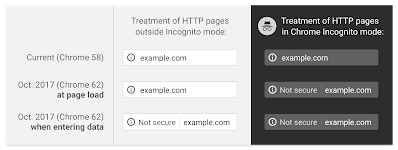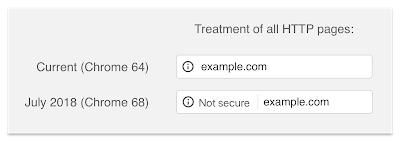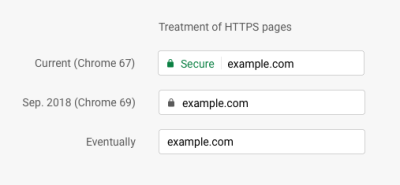Why you need to switch to https:
- Because Google wants you to (and we all know how important it is to keep them happy!)
- Because 47% of your web traffic is likely to be impacted [source]
- Because the longer you leave it, the greater the impact on your website traffic
The issue of website security is becoming increasingly mainstream as businesses look for ways to improve safety for themselves and their customers. Upgrading a website from HTTP to HTTPS has been gaining a lot of focus in recent years, and with browsers currently highlighting any website that doesn’t have an SSL certificate, now is a great time to make the change.
Browsers are now highlighting non-HTTPS sites, and it will get more promonent as time goes on – the images below show Chrome’s progression plans over time, from v53 up to 69 and beyond (68 will be released next month): [source]

Traditionally HTTPS has been used to protect user privacy during data exchanges; i.e. financial transactions. But in the last decade the use of HTTPS has become more widespread across all pages of a website to provide added levels of protection for both users and the sites themselves.
The techie bit
Data sent using HTTPS is secured via Transport Layer Security protocol (TLS), which provides three key layers of protection via encryption, data integrity and authentication.
It also has potential SEO advantages: research from the Google Webmaster blog found that adding an SSL to a website gave it a slight ranking boost. However, the ranking boost is minimal, and websites could even see a temporary drop in position as Google checks the site and acknowledges the new URLS.
Does https really make the web more secure?
There are certainly limitations to the protections provided by HTTPS; for example, it can’t eliminate persistent attacks or network hacks. But the data encryption created through a secure transfer protocol protects both the website and its users from external interference to the traffic between their browsers and the website, while also improving overall user privacy.
A useful tool to check your site after you’ve switched to https
If you do make the switch, visit https://www.jitbit.com/sslcheck/to scan your website for non-secure content.
It seems that the overall benefits outweigh any potential disadvantages, and with most aspects of life being conducted increasingly online, we think that any extra security has to be a good thing.
Coming soon – our WordPress https checklist – watch this space!








